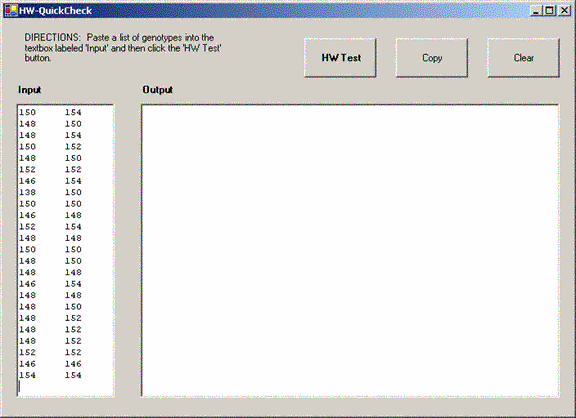HW-QuickCheck
Software for checking genotypes for agreement with Hardy-Weinberg expectations
Introduction
There are many programs for comparing genotypes with Hardy-Weinberg expectations. HW-QuickCheck may be the simplest. You paste a list a genotypes into a textbox and HW-QuickCheck tests the genotypes for equilibrium using a nice set of exact tests. It is designed to be used early in the genotyping process so that allelic dropout and null alleles can be detected as soon as possible.
Instructions for use
Paste a lists of genotypes genotypes into the textbox labeled 'Input' and then click 'Check." Genotypes may be in one of three formats.
- Tab delimited; each allele separated by a tab. This format is compatible with pasting genotypes from a spreadsheet.
- Space delimited; each allele separated by a space.
- GENEPOP format (either 4 or 6 digits).
Documentation
The statistical tests performed by HW-QuickCheck are described in the manuscript below:
- Kalinowski ST (In review) HW-QuickCheck: an easy-to-use computer program for checking genotypes for agreement with Hardy-Weinberg expectations. Molecular Ecology Notes.
System Requirements
HW-QuickCheck runs on the Microsoft Windows operating system that has the .NET platform installed. See my Software page for instructions on how to install this on your computer (it may already be there).
Right-click here to download HW-QuickCheck.
Installation / UnInstallation
Click on HW-QuickCheck.exe to run. Delete HW-QuickCheck.exe to "uninstall."
User Interface
The user interface for HW-QuickCheck looks like this:

Sample Output
Here is a sample output from the program:
SUMMARY
Sample size: 59
N alleles: 6
Hobs: 0.64
Hexp: 0.78
ALLELE FREQUENCIES
138 0.01 <-- Singleton
146 0.08
148 0.26
150 0.29
152 0.23
154 0.13
GLOBAL TEST OBS EXP SIGN P VALUE
Homozygotes 21 13.1 >
Heterozygotes 38 45.9 <
0.0101
HOMOZYGOTES OBS EXP SIGN P VALUE
138/138 0 0.0 = ns
146/146 1 0.4 + ns
148/148 5 4.0 + ns
150/150 6 4.8 + ns
152/152 7 3.0 + 0.006
154/154 2 0.9 + ns
HETEROZYGOTES OBS EXP SIGN P VALUE
138/146 0 0.1 - ns
138/148 0 0.3 - ns
138/150 1 0.3 + ns
138/152 0 0.2 - ns
138/154 0 0.1 - ns
146/148 3 2.6 + ns
146/150 2 2.9 - ns
146/152 1 2.3 - ns
146/154 2 1.3 + ns
148/150 10 9.0 + ns
148/152 5 7.2 - ns
148/154 3 4.0 - ns
150/152 5 7.8 - ns
150/154 4 4.4 - ns
152/154 2 3.5 - ns
NOTES
1. P-values reported above are for one tailed tests.
For example, if there is an excess of homozygotes,
the P-value is the one tailed probability of observing this number
(or more) homozygotes (conditional on the alleles counts observed
in the sample). If there is a deficiency of homozygotes, the P-value
is the one tailed probability of observing this few homozgyotes.
2. P-value for two tailed tests can be obtained by doubling the
P-values reported here.
3. ns indicates that a P value is > 0.10.
4. Only complete genotypes are included in the analysis. Genotypes missing
data for one allele are not included.
5. The P-value for the global test is obtained via a randomization test,
and, therefore, will be slightly different each time it is calculated.
All the other P-values are calculated analytically.
